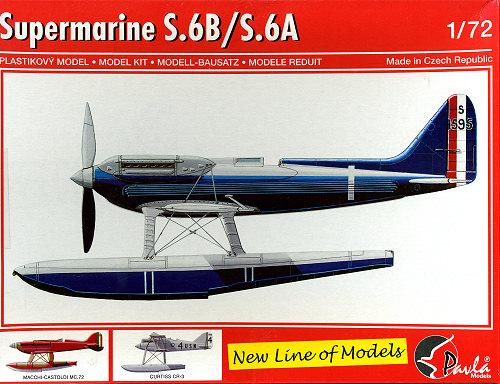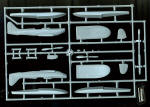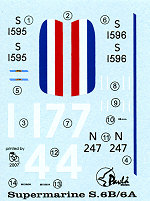
Pavla 1/72 Supermarine S.6A/B
| KIT: | Pavla 1/72 Supermarine S.6A/B |
| KIT #: | 72060 |
| PRICE: | $ |
| DECALS: | Three options |
| REVIEWER: | Scott Van Aken |
| NOTES: | Short run with resin and vacuformed parts |

| HISTORY |
The Supermarine S.6B was a racing seaplane developed by Reginald Mitchell for the Supermarine company in order to win the Schneider Trophy in 1931. It was the last in the line of racing seaplanes developed by Supermarine and followed the S.4, S.5 and the S.6.
After pressure by Lucy, Lady Houston and several newspapers, the British Government belatedly agreed to support the Royal Air Force's entry to defend the trophy. There were only nine months to prepare and so Supermarine's designer, Reginald Mitchell, could only update the S.6 airframes that had won the trophy in 1929. Rolls-Royce increased the power of the R-Type engine by 400 hp to 2,300 hp. The improved aircraft was called Supermarine S.6B. The winning flight was piloted by Flt Lt JN Boothman in aircraft serial number S1595 at a speed of 340.08 mph (547.19 km/h), though the technical achievement is slightly tarnished by the fact no other teams competed; two S.6B and an S.6 were the only participants. Seventeen days later S6B serial number S1596 broke the world air speed record reaching 407.5 mph (655.67 km/h).
The S.6B is often hailed as giving the impetus to the development of the Supermarine Spitfire and the Rolls Royce Merlin engine. S 1595 is on display at the Science Museum in London, England.
| THE KIT |
 The bright red
bordered box tells that this is a new series and there will be at least two
other Schnieder Trophy racers to come. I guess it is natural to start off with
the most well known of them, the ultimately triumphant Supermarine S.6. Prior to
this kit, the S.6 has only been served to us in the styrene medium by a very
old, but still buildable Airfix kit that has to have its origins in the late
1960s.
The bright red
bordered box tells that this is a new series and there will be at least two
other Schnieder Trophy racers to come. I guess it is natural to start off with
the most well known of them, the ultimately triumphant Supermarine S.6. Prior to
this kit, the S.6 has only been served to us in the styrene medium by a very
old, but still buildable Airfix kit that has to have its origins in the late
1960s.
This kit
contains a single injected plastic sprue, which contains the bulk of the
airframe. Molding is to high standards with nicely engraved panel lines where
needed. The plastic feels a tad rough, but the usual fine sanding will take care
of that. The tiny cockpit is quite complete with a seat, floor with rudder
pedals, control stick, instrument panel and forward bulkhead. A pair of
 vacuformed canopies are included.
The fuselage has a separate 'keel' that needs to be added as well as two resin
engine bank covers. Floats and struts are injected as well. Those wishing to
model S 1595 will need to modify the profile of the rudder and that is shown.
Two different props are also given; one a bit more paddle bladed
vacuformed canopies are included.
The fuselage has a separate 'keel' that needs to be added as well as two resin
engine bank covers. Floats and struts are injected as well. Those wishing to
model S 1595 will need to modify the profile of the rudder and that is shown.
Two different props are also given; one a bit more paddle bladed than the other, though no indication is provided as to which of the three
markings options it is to fit.
than the other, though no indication is provided as to which of the three
markings options it is to fit.
The bulk of the resin is for a beaching dolly or wooden sawhorses. The modeler will need to use some stretched sprue or short wire for things like axles, mass balance supports, and a prop shaft (if one desires). Instructions are quite well done and provide a complete rigging diagram. All three options are painted the same; Aluminum and Dark Blue. Humbrol, Agama and FS 595 color references are supplied. Decals are superbly done and should provide little problems if one is careful as they have proven to be quite thin.
| CONCLUSIONS |
It is great to see that someone is finally giving us some racing planes. This is a genre that has only been sporadically produced and usually to larger scales. Like many of you, I am very much looking forward to others and this one is headed for the work bench.
| REFERENCES |
http://en.wikipedia.org
November 2007 Thanks to
Pavla Models If you would like your product reviewed fairly and quickly, please
contact
me or see other details in the
Note to
Contributors. .
for the review kit. You can get yours direct or from your local hobby store.
.
for the review kit. You can get yours direct or from your local hobby store.